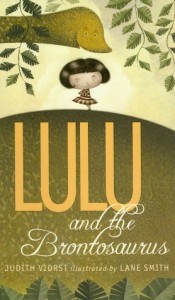 Lulu and the Brontosaurus
Lulu and the Brontosaurus is a delightful book for younger readers. With short chapters and illustrations by the wonderful Lane Smith on every page, it’s great for kids who are transitioning from picture books to chapter books. That said, it’s likely to appeal to older kids as well because of its sense of humor.
The narrator is clearly the author, Judith Viorst, who routinely breaks the 4th wall and plays with the readers’ expectations of what a book should be. She frequently reminds us that it’s her book, so she can do what she likes with it (such as using “brontosaurus” instead of “apatosaurus”). She points out some of the logical questions that a reader might have and says she can get away with it because she’s the author. She writes several endings, explaining her reasoning as she does it. In some ways, the book offers a way to talk with your kids about writing their own stories.
Lane Smith’s illustrations are wonderful, even though the snake is really freaky! There’s an off-kilter aspect to the world he creates that reminds me a bit of Maurice Sendak. There are tons of little details that will reward the observant reader, and especially a symbolic thinker (don’t those tree trunks look a lot like legs?).
SPOILER ALERT: Things you might want to know before suggesting this to your kid
Family
Lulu’s parents spoil her, giving in to temper tantrums. When they finally stand up to her, she throws a huge temper tantrum and then she runs away. Relieved by the quiet, they have tea and cookies—they expect her to come back soon, so they don’t worry that she’s gone. And then they forget about her! She does eventually return home and they’re happy to see her. (Viorst decides that one of her endings needs to explain why Lulu’s parents weren’t insanely worried about her.)
Questionable Hero
Lulu is pretty awful. She’s a spoiled brat who will do anything to get her own way. She’s the poster child for entitlement. She kills bugs that annoy her, even though she’s the one who entered their habitat. She sings loudly and repeatedly, disturbing the whole forest. When she comes up against a snake, a bear, and a tiger who intend to eat her because she’s so annoying, she just out-means them. Still, she’s our hero and we don’t really want her to get eaten, even if she kind of has it coming.
She does get a bit better by the end, although she doesn’t become perfect. She gives gifts to the animals she hurt, hoping to make up for what she did (and also to avoid the distraction of something trying to eat her while she’s trying to get home as quickly as she can). She makes it clear that she will stomp them again if necessary, but she’d rather just give them gifts and be on her way.
Kidnapping
The brontosaurus turns the tables on Lulu, deciding to keep her as a pet. Because she’s a kid and not an animal, the fact that she’s kept there against her will is a little more disturbing. But it does give her a taste of her own medicine (she fully intended to keep the brontosaurus as a pet regardless of what it wanted) and she’s more generous and thoughtful by the end.
The author is sympathetic toward the kidnapping brontosaurus—it was lonely and self-centered, not malicious. In two of the endings, we get a compromise where Lulu and the brontosaurus are friends instead of keeping each other as pets.
Recommendation
This funny and irreverent book is wonderful for kids with a certain sense of humor—my kids are certainly in that group. We giggled pretty hard over this story. It’s definitely aimed at younger readers, but it’s rewarding for older readers, too.
Son Update
My son actually gave this book some thought; he asked each of us what our favorite ending was. His is the second one, because there’s a happier ending but Lulu isn’t perfect—she’s still kind of a snot, which fits with her character. It’s possible I’ve talked to him about this idea before—I know I’ve written about it before—but I even though I thought about it with this book, I know I didn’t discuss it with him. The alternate endings, and the idea that he could pick one he liked best, engaged his thinking about story in a very overt way. A silly book naturally took him to a place that any reading teacher would be thrilled about!
Related Tangent
I have to plug some picture books by Judith Viorst and Lane Smith. They’re responsible for several of my family’s favorite stories:
Alexander and the Terrible, Horrible, No Good, Very Bad Day – still one of the most quoted books in our family. It has a message that transcends age. I was just talking about this with my daughter the other day, because some days are like that. Even in Australia.
The Happy Hocky Family – a hilarious take on early readers. This isn’t so much quoted as appropriated in our household (The “Do you have a balloon? I have a balloon. Do you have a balloon?” joke works for any noun). Parents and teachers really ought to read this one.
The Stinky Cheese Man and Other Fairly Stupid Tales, The True Story of the Three Little Pigs, and Math Curse with Jon Scieszka are all still favorites in our house. As many picture books get relegated to bins or passed on to younger kids, these stay in active rotation on our bookshelves.
Lulu and the Brontosaurus by Judith Viorst and Lane Smith
Published in 2010 by Atheneum Book for Young Readers
Has a sequel, Lulu Walks the Dogs
Read our personal copy





Speak Your Mind